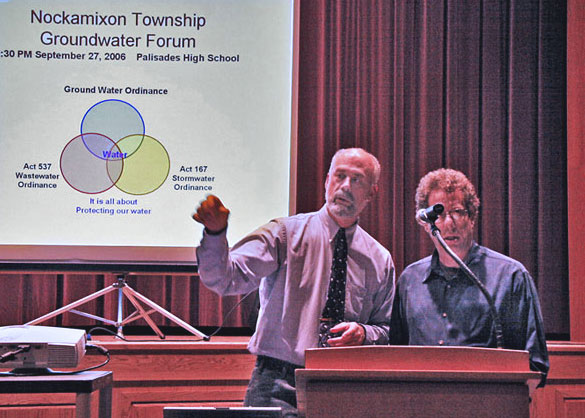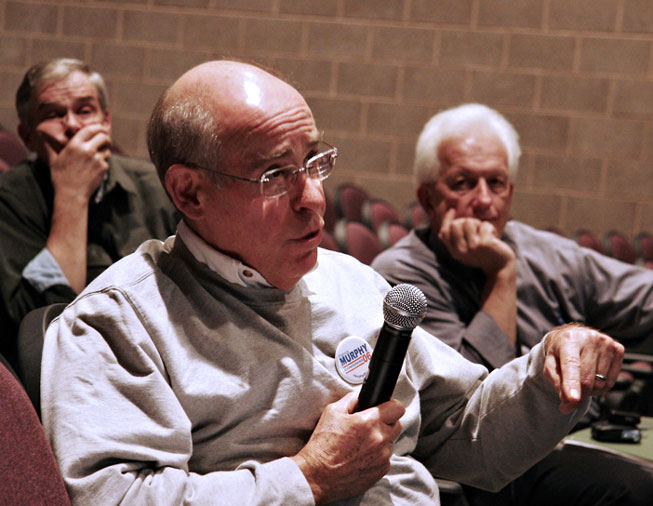Nockamixon draft ordinance must still pass several hurdles.
by John Blackford
The Nockamixon Planning Commission agreed last week to forward to the supervisors a draft groundwater ordinance being developed by the Bridgton-Nockamixon-Tinicum Joint Groundwater Committee. It’s goal is to ensure adequate water supply to township residents and businesses.
Dr. Stephen Donovan, of Nockamixon’s Environmental Advisory Committee and the
Next, the draft ordinance will go to the township engineer and the solicitor for revisions before going back to the planning commission and the supervisors for formal approval.
Kicking off this process, a public presentation held Sept. 27 at
Presenters were Donovan, Todd Stone, Cooks Creek Watershed Association, Dr. Robert Stanfield,
Donovan explained that the subsurface geology in Nockamixon does not hold water well, consisting of dense rock below a thin layer of soil. Thus, he said, any new development should be able to absorb enough water on the ground it occupies to keep the aquifer supplied.
The two ways to achieve this, said Donovan, are to limit development to sustainable water use or to construct municipal water-treatment facilities, which he said would destroy the area’s rural character.
Most of the subsurface rock in the area has few of the fissures that hold water and allow it to flow from one area to another, said Matt Mulhall. Where rock is well fissured, a well can draw water from a large part of the local aquifer.
Of the three main formations in the township, Mulhall said only the
Because of the poor geology, Robert Stanfield said continued development in the area risks wells running dry and groundwater becoming contaminated. However, he noted that ensuring adequate groundwater supply will largely eliminate the contamination issue, since materials such as nitrates are diluted to safe levels with adequate groundwater supply.


Todd Stone explain groundwater ordinance; (left photo) Tinicum resident Neil Kyde comments.

The maximum safe concentration of nitrates in water is ten parts per million, said Stanfield. The source of the nitrates is almost exclusively human activity, either from fertilizer or septic systems.
The ordinance should ensure adequate water supply, even during periods of drought, said Stanfield. “We want to make sure neighbors equitably share a common resource,” he said. Ultimately, Stanfield said setting limits is political, based on how much risk residents are willing to face.
For example, adequate water supply has been calculated according to the recharge area required to maintain a base level of flow in Tohickon Creek. Maintaining the base flow in the creek is related to water available to the aquifer, providing a means to estimate a lot size that can ensure well-water supply.
The risk factor involves whether the ordinance is based on water available during a 10-year drought or a 50-year drought, and what percentage of the stream’s base flow would be accounted for by a given lot size. A 100% figure means the lot accounts for all the stream’s base flow, with none left over. This is not considered sustainable. Figures of 50% to 30% are sustainable, with 30% the more conservative of the two.
The planning commission recommendebeginning with a working figure of meeting 30% of base flow during a 50-year drought, though Donovan plans to suggest 50% to the supervisors. In
The current Nockamixon zoning ordinance limits residences to two-acre minimum lot size, and the new groundwater ordinance wouldn’t necessarily change that, said Steve Baluh.
Instead, the ordinance would function like an added regulator: To meet groundwater recharge requirements, lots would have to be sized according to the water-carrying capacity of the strata below. In any case, said Baluh, current lot sizes in Nockamixon are averaging five to 10 acres each.
The proposed groundwater ordinance will coordinate with ordinances for management of waste water (Act 537) and storm water (Act 167).
Stanfield noted that the concept of natural-resource-based regulations has been tested in court in
During the Q & A session, Tinicum resident Neil Kyde expressed concern that the ordinance might not survive legal challenges, despite the legal precedent on natural-resource regulation. The earlier case, he said, was not appealed to higher courts, but a challenge to the groundwater ordinance might be.
-end-